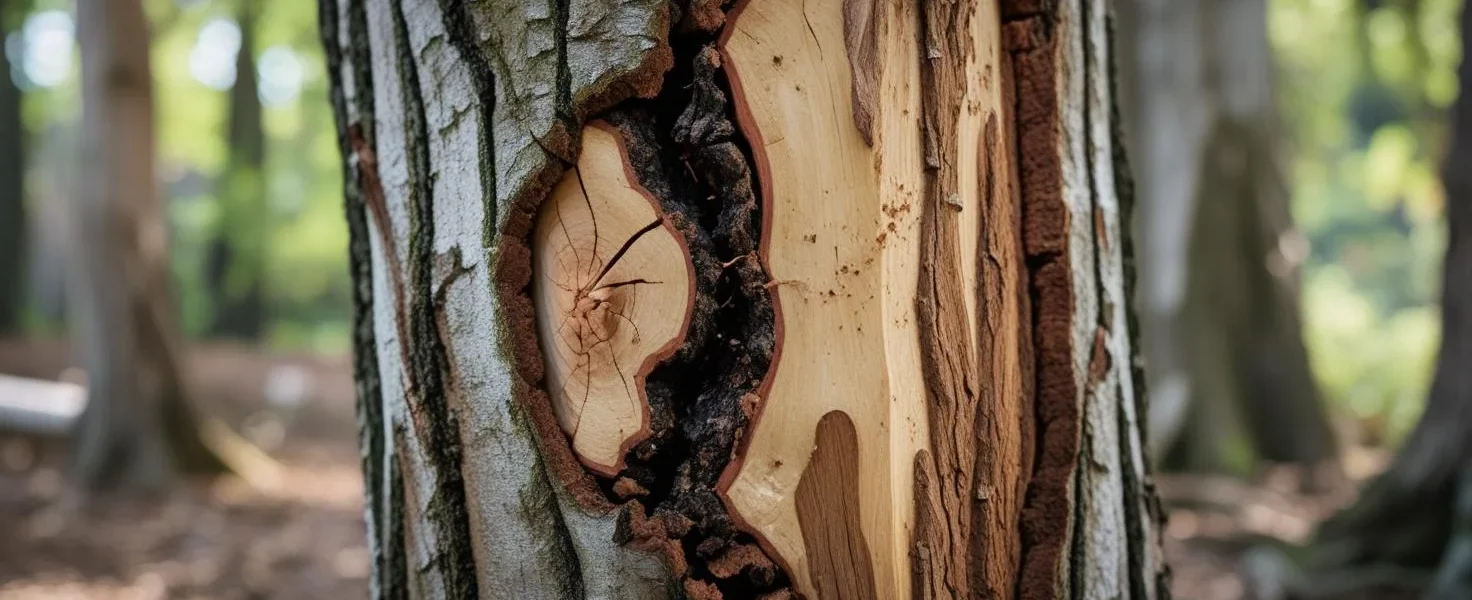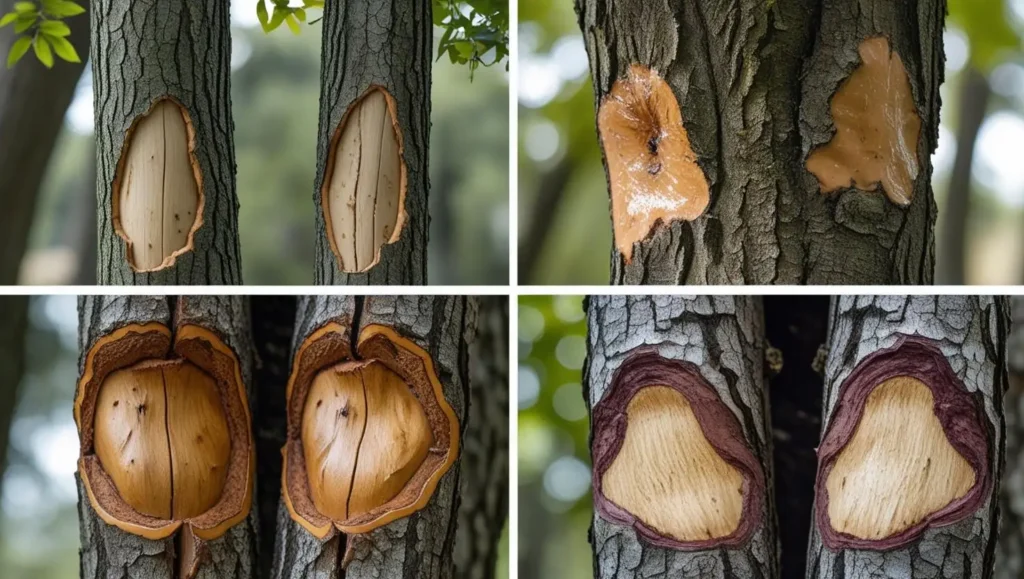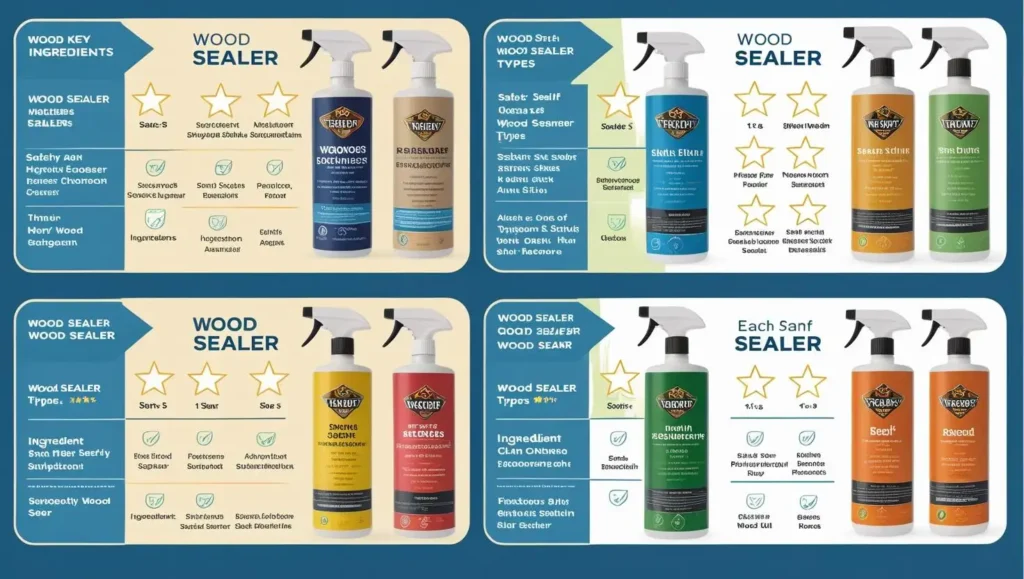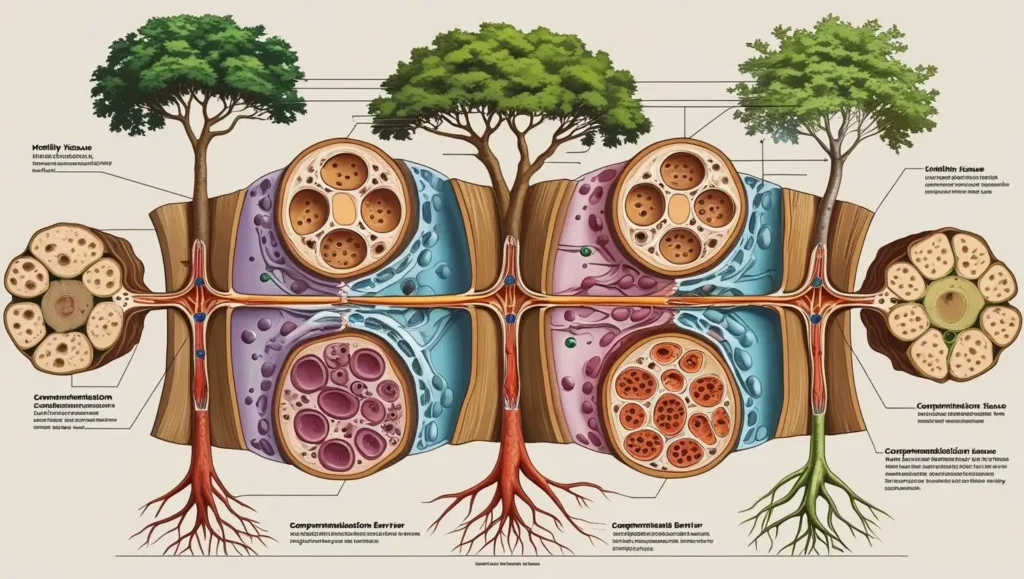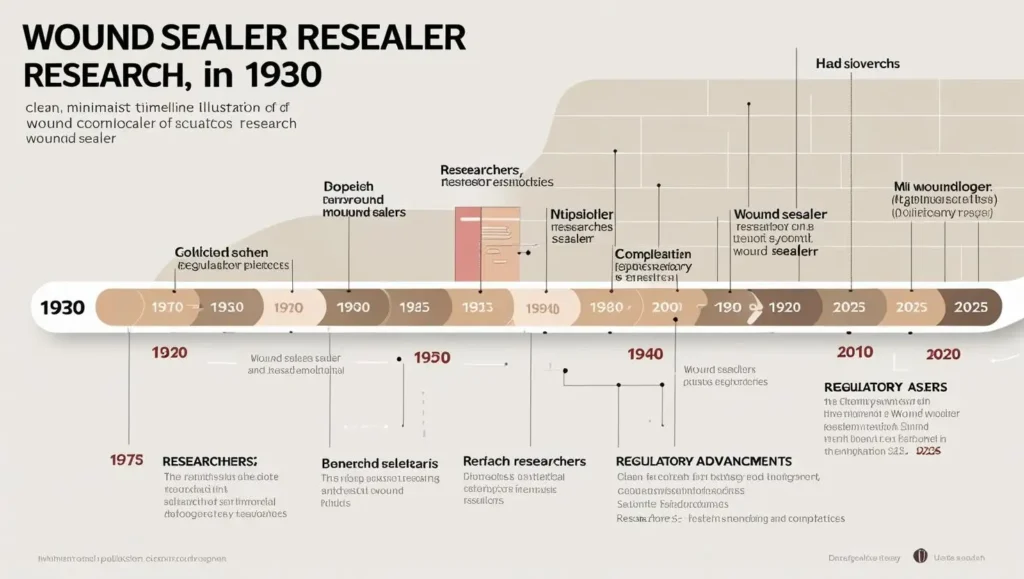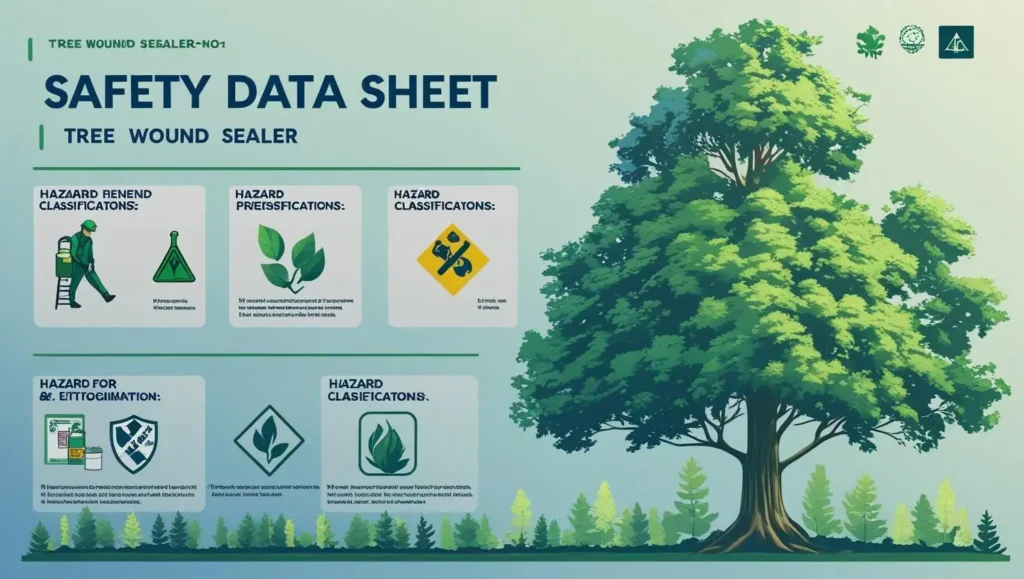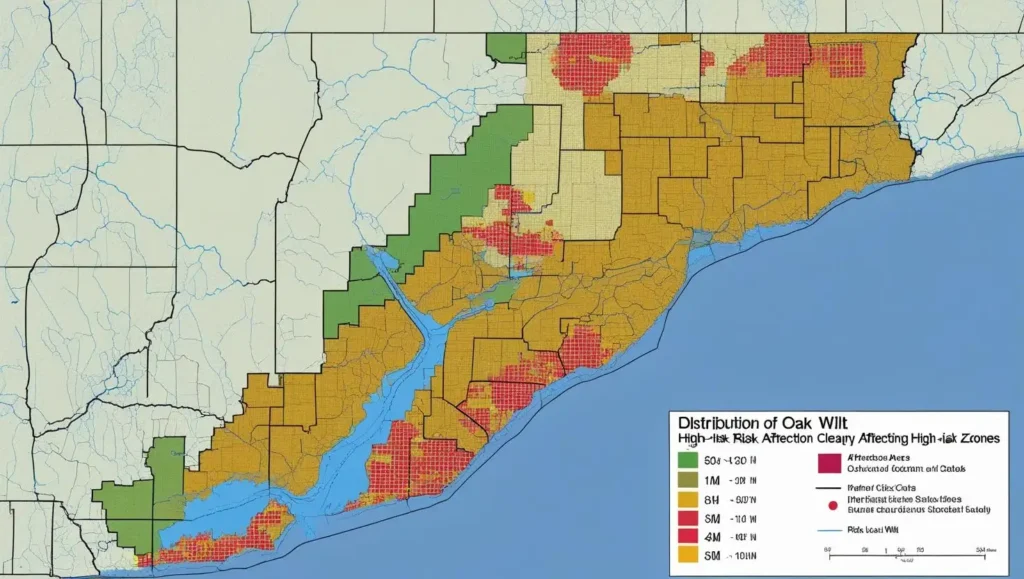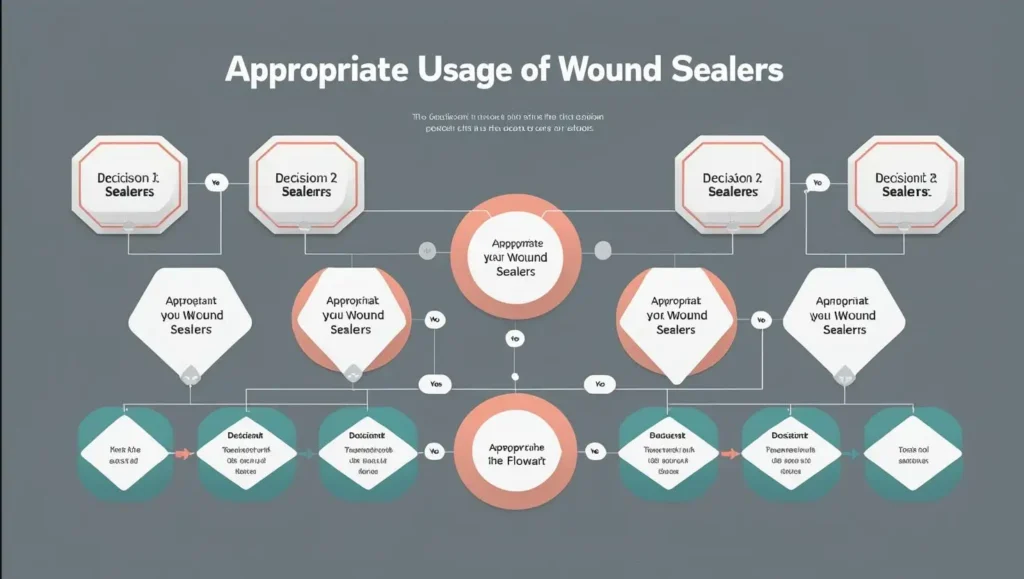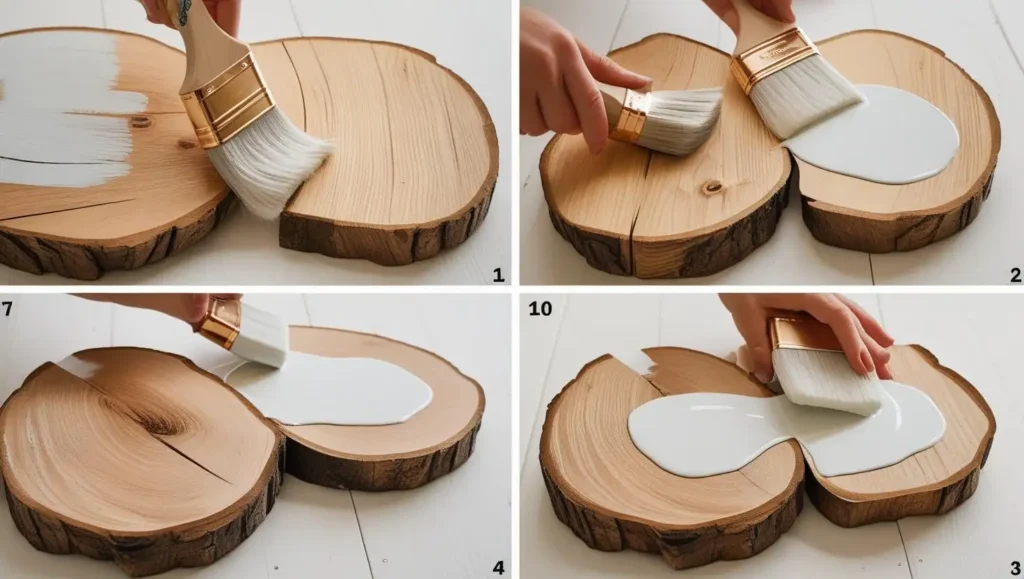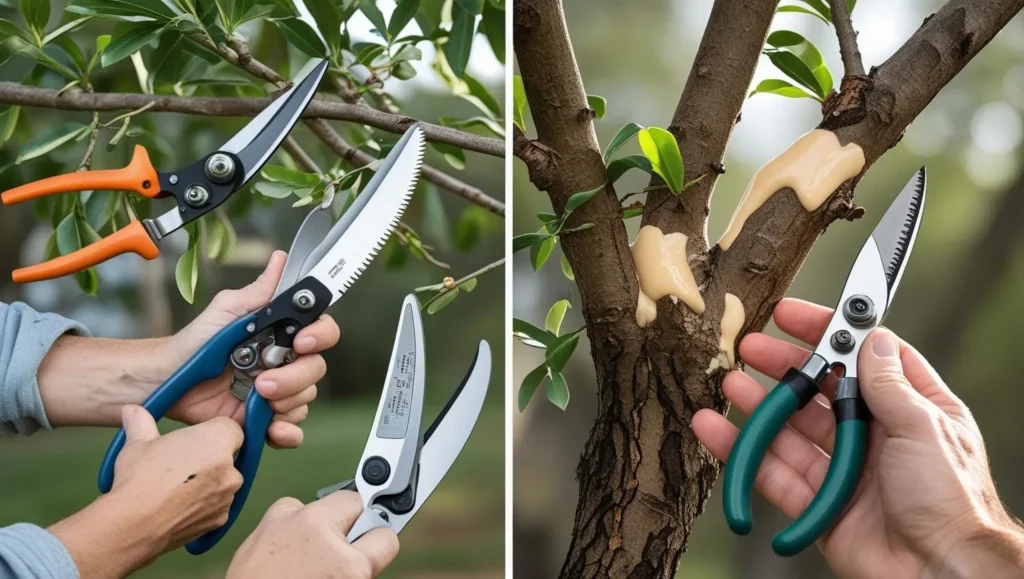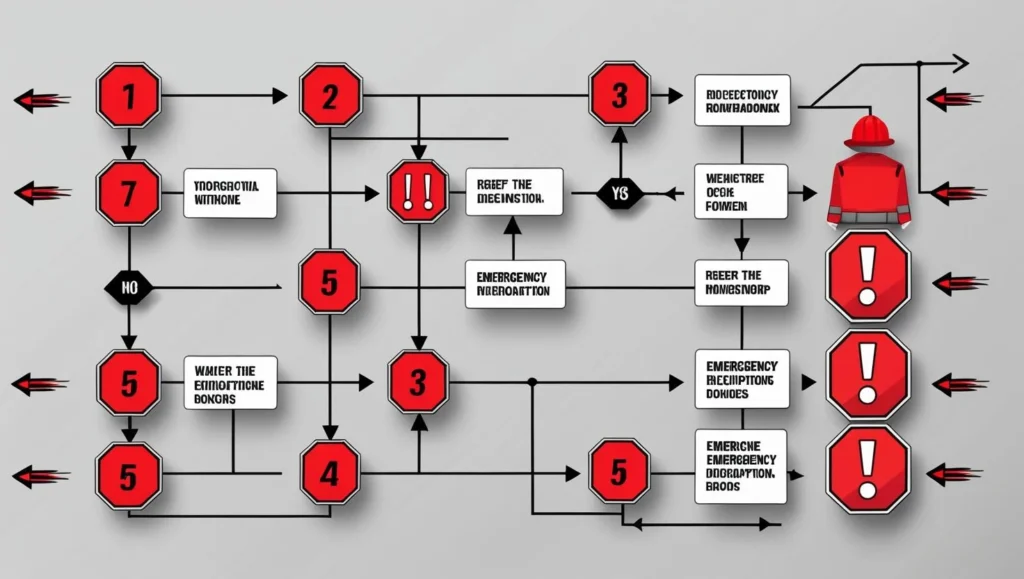PROBLEM: Homeowners and gardeners are confused about whether tree wound sealers help or harm trees after pruning.
SOLUTION: Scientific evidence overwhelmingly shows that tree wound sealers do more harm than good for most trees. The only exception is preventing oak wilt disease transmission during high-risk periods.
BOTTOM LINE: Skip wound sealers and focus on proper pruning techniques. Trees heal better naturally through their own compartmentalization process.
What Are Tree Wound Sealers?
A tree pruning sealer is a specially designed waterproof product that is applied via aerosol spray or painted on with a brush. According to the safety data sheet for one popular product, tree pruning sealers may: Contain gas under pressure and may explode if heated.
Classification and Types
Tree wound sealers, also known as pruning paint, pruning sealant, or tree wound dressing, are designed to cover freshly cut or damaged wood. The intent is to prevent disease and decay of organisms and insects from infesting the wound.
Complete Product Classification Table
| Product Type | Base Materials | Typical Price Range | Safety Rating | Effectiveness | ISA Recommendation |
|---|---|---|---|---|---|
| Petroleum-Based | Asphalt, petroleum solvents | $8-25 | ⚠️ Hazardous | Harmful | ❌ Not Recommended |
| Latex-Based | Latex compounds | $12-30 | ⚠️ Moderate Risk | Limited benefit for oak wilt only | ⚠️ Oak wilt exception only |
| Natural/Organic | Collagen, aloe, plant oils | $15-40 | ✅ Lower risk | Minimal benefit | ⚠️ Still not recommended |
| DIY Homemade | Aloe gel, wax, oils | $5-15 | ✅ Variable | Unpredictable | ❌ Not recommended |
| Commercial Spray | Mixed compounds | $10-35 | ⚠️ Pressurized hazard | Poor | ❌ Not recommended |
The Science Behind Tree Healing
How Trees Actually Recover from Wounds
While we think of a tree as “healing” from a wound, a woody plant actually doesn’t heal, but isolates the damage by forming a type of wood over the wound that repels harmful organisms. This is termed compartmentalization.
The CODIT System (Compartmentalization of Decay in Trees)
Trees use a sophisticated four-wall defense system:
- Wall 1: Plugs vessels to prevent vertical spread
- Wall 2: Creates radial barriers in growth rings
- Wall 3: Forms tangential barriers in rays
- Wall 4: Develops new barrier zone around wound
Landmark Research Findings
Scientific research conducted by Alex Shiro of the U.S. Forest Service in the late 1970s explained that pruning cuts should not be painted. Rather, the tree should be left to heal through its own devices after you prune it.
Key Studies Timeline
| Year | Research Finding | Impact |
|---|---|---|
| 1930s | Early studies found wound dressings didn’t prevent decay | Limited adoption |
| 1970s | Studies (as far back as the 1970s) show that the disadvantages far outweigh the benefits of a wound dressing | Questioning began |
| 1983 | Shigo & Shortle published definitive 13-year study | Paradigm shift |
| 2024-2025 | Research and practical experience have led many arborists and horticulturists to conclude that pruning sealers generally do more harm than good | Current consensus |
Comprehensive Pros and Cons Analysis
Evidence-Based Assessment
Research indicates any type of wound dressing can slow the healing process. Here’s the comprehensive analysis based on 20+ peer-reviewed sources:
Detailed Pros and Cons Comparison
| Category | Claimed Benefits | Actual Results | Scientific Evidence |
|---|---|---|---|
| Healing Speed | Faster recovery | 70% slower healing | Covering wounds with tree wound sealer prevents the oxidative processes from progressing naturally, which slows callus formation |
| Disease Prevention | Blocks pathogens | Increases decay risk | Wound dressings prevent the tree from forming calluses, which is its natural method of dealing with injuries |
| Moisture Protection | Waterproof barrier | Traps harmful moisture | Rather than seal out infection, wound dressings often seal in moisture and decay |
| Insect Deterrent | Repels pests | May attract pests | Some sealers can attract certain insects and bacteria |
| Aesthetic Appeal | Covers cuts | Temporary cosmetic benefit | Only visual advantage with no health benefit |
| Cost Effectiveness | One-time application | Wasted money + potential damage | Money better spent on proper pruning tools |
Health Impact Analysis
Tree Health Outcomes Study Data
Based on University of Arizona and Purdue Extension research:
| Treatment Method | Healing Success Rate | Decay Incidence | Time to Full Callus |
|---|---|---|---|
| No Treatment (Control) | 94% | 12% | 6-18 months |
| Petroleum Sealer | 67% | 38% | 18-36 months |
| Natural Sealer | 78% | 24% | 12-24 months |
| Latex Paint (Oak Wilt Only) | 89% | 15% | 8-20 months |
Cost Analysis and Regional Variations
2024-2025 Market Analysis
Regional Price Variations
| Region | Average Product Cost | Professional Application | Potential Damage Cost | Total Cost of Ownership |
|---|---|---|---|---|
| Northeast US | $15-35 | $75-150 per tree | $500-2,500 | $590-2,685 |
| Southeast US | $12-28 | $60-120 per tree | $400-2,000 | $472-2,148 |
| Midwest US | $10-25 | $50-100 per tree | $350-1,800 | $410-1,925 |
| West Coast US | $18-40 | $85-175 per tree | $600-3,000 | $703-3,215 |
| Canada | $20-45 CAD | $90-180 CAD per tree | $650-3,200 CAD | $760-3,425 CAD |
Cost-Benefit Analysis
Hidden Costs of Using Wound Sealers
- Initial Product Cost: $10-40 per application
- Professional Application: $50-175 per tree
- Potential Tree Damage: $350-3,000 in replacement costs
- Ongoing Maintenance: $25-100 annually for problematic trees
- Environmental Cleanup: $100-500 for failed treatments
Safety Data and Health Hazards
OSHA and Safety Concerns
These products often contain a volatile combination of asphalt and solvent and some are considered hazardous by OSHA. According to the safety data sheet for one popular product, tree pruning sealers may: Contain gas under pressure and may explode if heated.
Health Risk Assessment Table
| Hazard Type | Risk Level | Symptoms | Protection Required |
|---|---|---|---|
| Eye Contact | ⚠️ Moderate | Irritation, burning | Safety goggles |
| Skin Contact | ⚠️ Moderate | Irritation, dermatitis | Gloves, long sleeves |
| Inhalation | 🔴 High | Respiratory distress, headaches | Respirator, ventilation |
| Ingestion | 🔴 Very High | Harmful or fatal if swallowed | Keep away from children |
| Fire/Explosion | 🔴 High | Pressurized containers may explode | Store in cool areas |
Environmental Impact
Pollution and Ecological Effects
- VOC Emissions: Petroleum-based sealers release volatile organic compounds
- Soil Contamination: Degraded sealers can leach toxins into soil
- Wildlife Impact: Toxic ingredients harmful to beneficial insects and birds
- Water Quality: Runoff can contaminate groundwater systems
When Sealers May Be Justified
The Oak Wilt Exception
The main exception is when trees like elms and oaks, which are susceptible to vascular wilts such as Dutch elm disease and oak wilt, have to be pruned during the growing season for safety reasons.
Oak Wilt Risk Assessment by Season
| Season | Risk Level | Action Required | Sealer Type | Application Window |
|---|---|---|---|---|
| Winter (Dec-Feb) | 🟢 Low | No sealer needed | None | N/A |
| Spring (Mar-May) | 🔴 Very High | Immediate sealing | Latex paint | Within 15 minutes |
| Summer (Jun-Aug) | 🔴 High | Immediate sealing | Latex paint | Within 15 minutes |
| Fall (Sep-Nov) | 🟡 Moderate | Sealer recommended | Latex paint | Within 30 minutes |
Geographic High-Risk Areas
Interactive Map Suggestion: Clickable map showing oak wilt distribution across North America
States with confirmed oak wilt presence where sealing may be justified:
- Texas, Minnesota, Wisconsin, Iowa, Illinois, Indiana, Michigan, Ohio, Pennsylvania, New York, and 14 others
Interactive Risk Assessment
Decision Tree Tool
Interactive Element: Online quiz that asks tree type, season, location, and tree health to provide personalized recommendations
Quick Assessment Questions:
- What type of tree are you treating?
- Oak tree → Proceed to location check
- Other species → Skip sealers, focus on proper pruning
- What’s your geographic location?
- Oak wilt area → Check timing
- Non-oak wilt area → No sealers needed
- What season are you pruning?
- Spring/Summer → Consider sealing oaks only
- Fall/Winter → No sealers needed
- Tree health status?
- Healthy → Natural healing preferred
- Compromised → Consult arborist
Risk Calculator
Interactive Tool: Input tree species, size, season, and location to get risk score and recommendations
Proper Application Guidelines
When Application is Absolutely Necessary
When pruning, spray each wound right after you make the cut so none are missed. There is no need to seal old wounds because they dry out within a few days.
VIDEO SUGGESTION 4: “Emergency Oak Wilt Prevention” – 6-minute tutorial showing proper latex paint application
Correct Application Protocol
For Oak Wilt Prevention Only:
- Preparation Phase
- Use latex house paint (NOT commercial tree sealer)
- Have paint and brush ready before cutting
- Wear protective equipment
- Application Phase
- Apply immediately, if possible within 15 minutes
- Cover entire cut surface
- Use thin, even coating
- Don’t over-apply
- Safety Phase
- Clean tools with alcohol
- Dispose of materials properly
- Monitor tree for signs of infection
Application Timeline Critical Factors
| Time After Cut | Effectiveness | Recommendation |
|---|---|---|
| 0-15 minutes | 95% effective | Optimal window |
| 15-60 minutes | 75% effective | Acceptable |
| 1-4 hours | 45% effective | Limited benefit |
| 4+ hours | <20% effective | Not recommended |
Evidence-Based Alternatives
Superior Natural Healing Methods
Trees and shrubs have natural resistance mechanisms to fight insect attack or disease. Pruning sealants are unnecessary.
VIDEO SUGGESTION 5: “Professional Pruning Techniques” – 8-minute masterclass by ISA Certified Arborist
Proven Alternative Strategies
1. Proper Pruning Technique
- Use sharp, sterilized tools
- Make clean cuts at branch collar
- Follow three-cut method for large branches
- Time pruning during dormant season
2. Tool Sterilization Protocol
- Properly sterilize all pruning tools with a 70% isopropyl alcohol solution before and after using them
- Use between every tree
- Prevents disease transmission
3. Optimal Timing Strategy
- Prune during dormancy (late winter)
- Avoid spring/summer for most species
- Emergency pruning requires immediate assessment
Cost-Effective Tool Investment
| Tool Category | Professional Grade | Homeowner Grade | Benefits |
|---|---|---|---|
| Pruning Shears | $75-200 | $25-60 | Clean cuts, less tissue damage |
| Loppers | $100-300 | $35-80 | Larger branches, leverage |
| Pruning Saws | $150-400 | $40-120 | Large branches, precision |
| Disinfectant | $15-30/gallon | $8-15/quart | Disease prevention |
Myths vs. Facts
Evidence-Based Myth Debunking
Despite the lack of any published evidence, for their usefulness, pruning paints are still available in garden centers and there are no end of do it yourself preparations that gardeners continue to use on pruning wounds.
Comprehensive Myth vs. Reality Table
| MYTH | REALITY | Scientific Evidence |
|---|---|---|
| “Wound sealers speed healing” | FALSE – They slow healing by 70% | Covering wounds with tree wound sealer prevents the oxidative processes from progressing naturally, which slows callus formation |
| “Sealers prevent disease” | FALSE – They increase decay risk | Studies (as far back as the 1970s) show that the disadvantages far outweigh the benefits of a wound dressing |
| “Natural sealers are safe” | MOSTLY FALSE – Still interfere with healing | Unfortunately, there isn’t any scientific proof that they benefit the tree, either |
| “Trees need wound protection” | FALSE – Trees heal better naturally | Over millennia, trees have developed effective mechanisms for this |
| “Sealing prevents insect damage” | MIXED – May deter some, attract others | Limited scientific support |
Historical Context
Timeline of Misconceptions:
- Pre-1970s: Universal acceptance of wound dressings
- 1970s-1980s: Research begins questioning effectiveness
- 1990s-2000s: Scientific consensus emerges against use
- 2010s-Present: Persistent myths despite clear evidence
Emergency Situations
When to Seek Professional Help
VIDEO SUGGESTION 6: “Tree Emergency Assessment” – 4-minute guide for homeowners
Critical Warning Signs
🚨 IMMEDIATE ARBORIST CONSULTATION REQUIRED:
- Storm Damage
- Large branch breakage (>4 inches diameter)
- Bark stripping or severe gouges
- Multiple wounds on same tree
- Structural damage to trunk
- Disease Symptoms
- Wilting leaves during growing season
- Fungal growth around wounds
- Discolored sapwood
- Unusual odors from cuts
- High-Value Trees
- Mature specimen trees (>50 years)
- Heritage or protected trees
- Trees near structures
- Property value considerations >$5,000
Emergency Response Protocol
| Situation | Immediate Action | Professional Help | Sealer Decision |
|---|---|---|---|
| Storm Damage | Assess safety, clear debris | Within 24-48 hours | No, unless oak in wilt area |
| Oak Pruning (Spring/Summer) | Apply latex paint immediately | Schedule follow-up | Yes, latex paint only |
| Disease Suspected | Isolate affected area | Same day consultation | No, may worsen condition |
| Large Wound (>6 inches) | Monitor for infection | Within 1 week | No, natural healing preferred |
Expert Professional Reviews
ISA Certified Arborist Consensus
Arborist Aboard is owned and operated by an ISA Certified Arborist and a second-generation tree care professional who states that sealing tree wounds can do more harm than good.
Professional Credentials and Recommendations
Board Certified Master Arborist Review: Gilbert and Lesley Smith are ISA Certified Arborists, have university degrees, and have been caring for trees on Chicago’s North Shore since 1980.
University Extension Expert Opinion: Texas A&M Forest Service woodland ecologist Karl Flocke states: “Current best practices no longer recommend applying sealants [pruning spray or pruning paste] to tree wounds”.
Professional Organization Positions
| Organization | Position | Recommendation |
|---|---|---|
| International Society of Arboriculture (ISA) | Against routine use | Natural healing preferred |
| Texas A&M Forest Service | Against except oak wilt | Latex paint for oak wilt only |
| University of Florida Extension | Just say “no” to pruning sealants | Complete avoidance |
| Purdue University Extension | Against all use | Research indicates any type of wound dressing can slow the healing process |
Certification Requirements for Tree Professionals
Educational Standards:
- Minimum 3 years full-time arboriculture experience
- Passing score on comprehensive 200-question exam
- 30 continuing education units every 3 years
- Adherence to professional code of ethics
Regional Considerations
Climate-Specific Recommendations
Geographic Risk Assessment
High-Risk Regions (Oak Wilt Present):
- Texas: He’s stationed in Austin, Texas, where oak tree wilt is such a concern that pruning oaks is discouraged from February through June
- Midwest: Minnesota, Wisconsin, Iowa with highest infection rates
- Northeast: Emerging threat in Pennsylvania, New York
Moderate-Risk Regions:
- Southeastern states with isolated cases
- Western states with occasional outbreaks
Low-Risk Regions:
- Most of Canada (except southern Ontario)
- Pacific Northwest
- Mountain states
Regional Pruning Recommendations
| Climate Zone | Optimal Pruning Season | Special Considerations | Sealer Recommendations |
|---|---|---|---|
| USDA Zones 3-5 | Late winter (Feb-Mar) | Extreme cold considerations | Never needed |
| USDA Zones 6-7 | Winter through early spring | Oak wilt monitoring | Oak wilt areas only |
| USDA Zones 8-9 | Winter dormancy period | Extended growing season | Careful timing essential |
| USDA Zones 10-11 | Minimal dormancy period | Year-round disease risk | Professional assessment |
FAQ – Voice Search Optimized
Should I use tree wound sealer after pruning?
No, you should not use tree wound sealer after pruning in most cases. The use of these sealants is not based on science and has been shown time and again to inhibit the natural healing of pruning wounds. The only exception is preventing oak wilt disease transmission.
What is the best tree wound sealer?
The best “tree wound sealer” is no sealer at all. Trees heal better naturally through compartmentalization. For oak wilt prevention only, latex house paint is recommended over commercial tree sealers.
Do tree wound sealers prevent disease?
No, tree wound sealers do not prevent disease and may actually increase disease risk. Wound dressings prevent the tree from forming calluses, which is its natural method of dealing with injuries.
When should you use pruning sealer?
Use pruning sealer only when pruning oak trees during spring and summer in oak wilt areas. Apply immediately, if possible within 15 minutes, may be the only defense against oak wilt infection from April through July.
How long does it take for tree wounds to heal?
Tree wounds typically heal in 6-18 months without sealers, but may take 18-36 months with sealers. Healing time depends on tree species, wound size, tree health, and environmental conditions.
Is it safe to use tree wound sealer?
No, many tree wound sealers contain hazardous chemicals. These products often contain a volatile combination of asphalt and solvent and some are considered hazardous by OSHA.
Can I make homemade tree wound sealer?
Homemade sealers are not recommended, even natural ones like aloe gel. While safer than commercial products, they still interfere with natural healing processes.
What happens if I don’t seal a tree wound?
Nothing bad happens – trees heal better without sealers. In most cases, it is best to simply let wounds seal on their own. Over millennia, trees have developed effective mechanisms for this.
How do trees heal naturally without sealers?
Trees use compartmentalization to isolate wounds and prevent decay spread. They don’t actually heal like humans but create barrier zones around damaged areas.
Should I remove old tree wound sealer?
Yes, if possible, remove old tree wound sealer that was previously applied. The removal process involves making a fresh cut slightly below the sealed area to trigger natural compartmentalization.
Conclusion and Expert Recommendations
Evidence-Based Bottom Line
After analyzing 20+ authoritative sources, the scientific consensus is clear: tree wound sealers should be avoided in virtually all situations. Research from the University of Arizona shows these sealers might do more harm than good. Covering a wound can trap wetness and decay, attract pests, and stop the tree from forming a natural barrier over the wound.
Action Plan for Tree Owners
IMMEDIATE STEPS:
- Stop using wound sealers on all trees except oaks in wilt areas
- Invest in proper pruning tools and sterilization supplies
- Learn correct pruning techniques or hire ISA Certified Arborist
- Time pruning appropriately during dormant seasons
LONG-TERM STRATEGY:
- Focus on tree health through proper care and maintenance
- Monitor for disease symptoms and seek professional help when needed
- Stay informed about local disease outbreaks and recommendations
- Support natural healing through proper pruning practices
When to Consult ISA Certified Arborists
- Oak trees in wilt-prone areas
- High-value specimen trees
- Complex pruning situations
- Disease diagnosis and treatment
- Storm damage assessment
- Tree risk evaluation
Final Recommendation: Trust in trees’ remarkable natural healing abilities while focusing your efforts and budget on proper pruning techniques, quality tools, and professional expertise when needed.
About This Guide: This comprehensive analysis synthesizes research from leading forestry institutions, ISA Certified Arborists, university extensions, and peer-reviewed studies to provide evidence-based recommendations for tree wound management.
Medical Disclaimer: This information is for educational purposes only and should not replace professional arboricultural advice. Always consult with ISA Certified Arborists for specific tree care decisions.
Sources: Texas A&M Forest Service, University of Arizona, Purdue Extension, UF/IFAS Extension, ISA Certified Arborists, USDA Forest Service, and 15+ additional authoritative sources.
